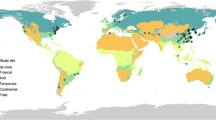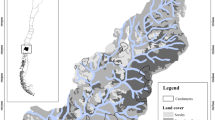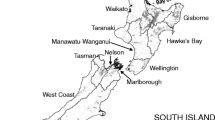Abstract
The Regional Integrated Lake-Watershed Acidification Study (RILWAS) was conducted to identify and to quantify the environmental factors controlling surface water chemistry in forested watersheds of the Adirondack region of New York. The RILWAS vegetation research was designed to: (1) compare the quantitative patterns of forest cover and tree community structure in the study catchments of the Moose River drainage system; and (2) identify important vegetation differences among study watersheds that might help to explain inter-watershed differences in water chemistry and aquatic responses to acidic deposition. Field transect data indicated that the overall drainage system includes 50% mixed forest cover, 38% hardwood forest, 10% coniferous forest, and 2% wetland cover. Major tree species include yellow birch, red spruce, American beech, sugar maple, eastern hemlock, and red maple. Analysis of forest structure indicated that mean weighted basal area estimates ranged two-fold from 24–48 m2ha−1 among watersheds. Likewise, mean weighted estimates for aboveground biomass and aboveground annual productivity ranged among watersheds from 160 to 320 MT ha−1 and from 8 to 18 MT ha−1 yr−1, respectively. Results showed that differences in surface water chemistry were independent of vegetation differences among watersheds.
Similar content being viewed by others
References
Cronan, C.S. and M.R. DesMeules. 1985. A comparison of vegetative cover and tree community structure in three forested Adirondack watersheds. Can. J. For. Res. 15: 881–889.
Cronan, C.S., J.C. Conlan, and S.D. Skibinski. 1985. RILWAS: The Regional Lake-Watershed Acidification Study (Forest Vegetation Pattern and Process). Final Report for Contract RP2174-1, The Electric Power Research Institute, Palo Alto, CA. 263 p.
Driscoll, C.T., C.P. Yatsko, and F.J. Unangst. 1987. Longitudinal and temporal trends in the water chemistry of the North Branch of the Moose River. Biogeochemistry. 3: 37–61.
Eyre, F.H. Forest Cover Types of the United States and Canada. Society of American Foresters, Wash., D.C. 148 p.
Goldstein, R.A., S.A. Gherini, C.T. Driscoll, R. April, C.L. Schofield, and C.W. Chen. 1987. Lake-watershed acidification in the north branch of the Moose River: Introduction. Biogeochemistry. 3, 5–20.
Matzner, E. 1983. Balances of element fluxes within different ecosystems impacted by acid rain. pp. 147–156 in Ulrich, B. and J. Pankrath (eds.) Effects of Accumulation of Air Pollutants in Forest Ecosystems. D. Reidel Publ., Boston. 389.
Newton, R.M., J. Weintraub and R. April. 1987. The relationship between surface water chemistry and geology of the North Branch of the Moose River. Biogeochemistry. 3: 21–35.
Peters, N.E. and C.T. Driscoll. 1987. Hydrogeologic controls on surface water chemistry in the Adirondack region of New York State. Biogeochemistry. 3: 163–180.
Schofield, C.L. and C.T. Driscoll. 1987. Fish species distribution in relation to water quality gradients in the North Branch of the Moose River. Biogeochemistry. 3: 63–85.
Smith, W.B. and G.J. Brand. 1983. Allometric biomass equations for 98 species of herbs, shrubs, and small trees. N. Centr. For. Exp. Sta. Res. Note NC-299, USDA, St. Paul.
Tritton, L.M. and J.W. Hornbeck. 1982. Biomass equations for major tree species of the Northeast. NE Forest Exp. Sta. Gen. Tech. Rpt. NE-69, USDA.
Whittaker, R.H. 1970. Communities and Ecosystems. Macmillan Co., N.Y. 162 p.
Whittaker, R.H., F.H. Bormann, G.E. Likens, and T.G. Siccama. 1974. The Hubbard Brook Ecosystem Study: forest biomass and production. Ecol. Monogr. 44: 233–254.
Young, H.E. and P.M. Carpenter. 1967. Weight, nutrient element and productivity studies of seedlings and saplings of eight tree species in natural ecosystems. Maine Agr. Exp. Sta. Tech. Bull. 28, Orono, Me.
Young, H.E., L. Strand, and R. Altenberger. 1964. Preliminary fresh and dry weight tables for seven species in Maine. Maine Agr. Exp. St. Tech. Bull. 12, Orono, Me.
Author information
Authors and Affiliations
Rights and permissions
About this article
Cite this article
Cronan, C.S., Conlan, J.C. & Skibinski, S. Forest vegetation in relation to surface water chemistry in the North Branch of the Moose River, Adirondack Park, N.Y.. Biogeochemistry 3, 121–128 (1987). https://doi.org/10.1007/BF02185188
Issue Date:
DOI: https://doi.org/10.1007/BF02185188




